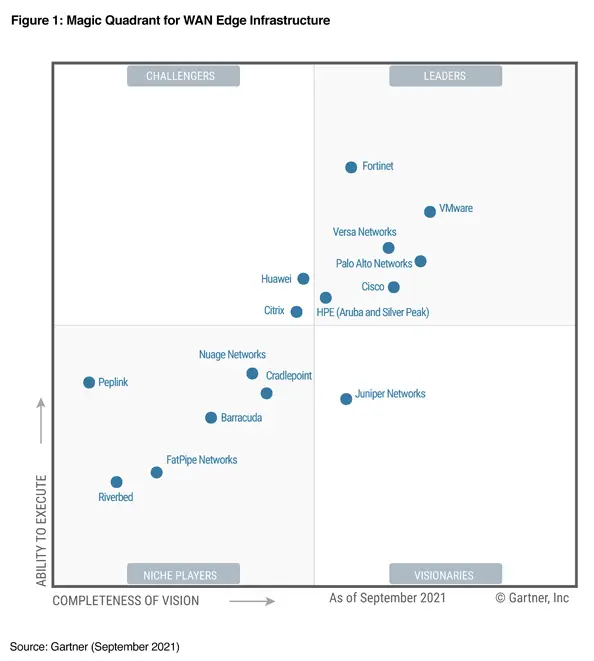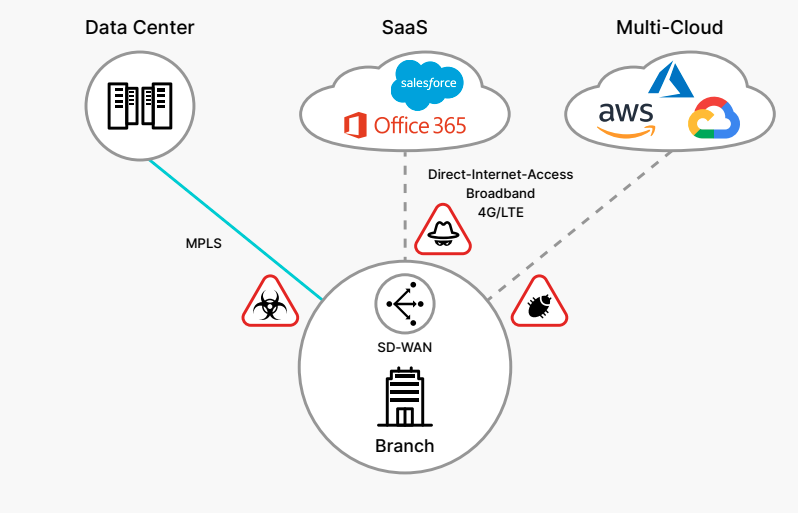SD-WAN Buyer’s Guide: 2024

The pandemic pushed digital transformation, forcing businesses to adopt modern solutions like SD-WANs to manage complex networks and remote work. This guide explains SD-WANs, their benefits, and how to choose a vendor.
What is SD-WAN?
SD-WAN isn’t one specific thing, but rather a network design that separates the data connection from the rest of the network controls.
The rise of cloud computing has made traditional WANs expensive and inflexible. MPLS is costly, takes too long to set up, and can’t adapt to changing application needs. SD-WAN offers a solution. It creates a virtual network overlay that separates data transport from network controls. This allows businesses to choose the “right transport for the right application”— using MPLS for critical traffic and affordable internet for less demanding applications. SD-WAN nodes act like intelligent traffic directors. They measure performance across different connections and use pre-defined policies to route traffic for optimal performance and cost efficiency. This goes beyond traditional IP routing, prioritizing traffic based on user-defined rules. Most SD-WAN solutions work with both internet and private data services.
In short, SD-WAN makes WANs more agile and cost-effective by offering intelligent traffic management across various connections.
SD-WAN cuts costs and simplifies network management for businesses by:
- Handling multiple connections and prioritizing traffic
- Offering better performance with lower-cost internet links
- Providing centralized visibility and manageability

5 Key Considerations When Selecting an SD-WAN Solution for your Enterprise
SD-WAN Vs Traditional WAN
SD-WAN transforms how businesses connect to cloud applications. Unlike traditional WANs, it acts as a smart traffic director. It can route traffic to applications hosted anywhere, from on-premise data centers to public clouds like Microsoft 365 or SaaS platforms like Salesforce.
This modern technology offers several benefits:
- Flexibility and Agility: Easily adapt to changing network needs.
- Cost Savings: Utilize a variety of connections for optimal cost-efficiency.
- High Performance: Reduce latency and jitter for smoother application performance.
Traditional WANs struggled with inconsistent data flow, causing delays and disruptions. SD-WAN solves this by intelligently routing traffic, optimizing performance across the entire network. This shift is driving significant growth in the network market, with SD-WAN playing a key role in digital transformation.
Does your Company Need SD-WAN and Are you Ready?
Traditional WANs were great for connecting branch offices, but they’re expensive, complex, and struggle with today’s cloud-based world.
- High costs: Maintaining WAN infrastructure is a constant drain on your budget.
- Cloud complexity: Cloud traffic patterns differ from traditional applications, leading to congestion and slowdowns.
- Bandwidth bottlenecks: Video conferencing and cloud apps eat up bandwidth, impacting performance.
- Slow deployments: Setting up a new branch office requires a technician visit for router configuration.
SD-WAN: The modern solution for your network
SD-WAN offers a smarter approach to networking, using software and virtualization to deliver:
- Cost savings: Reduce your dependence on expensive WAN infrastructure.
- Cloud agility: Optimize traffic flow for cloud applications, boosting performance.
- Simplified management: Deploy and manage your network from anywhere, with no need for on-site visits.
- Faster deployments: Get new branch offices online quickly and easily.
If you’re facing these challenges, SD-WAN can be the key to unlocking a faster, more cost-effective, and future-proof network for your digital transformation journey.
Flavors of SD-WAN: Appliance, Platform or Integrated Provider
1. Appliance: The initial method involves self-managing SD-WAN appliances (or utilizing Managed Service Providers) installed at the network edge. Although these devices possess cloud management capabilities, they do not route WAN traffic through their platforms. Instead, they focus on traffic shaping and prioritization within the LAN before reaching the local WAN interface. Examples include solutions from Cisco Meraki and Fortinet. Typically, these solutions entail a one-time capital expenditure and are often the most cost-effective option for deployment.
2. Platform: The second method entails adopting major proprietary cloud-based platforms such as VeloCloud, Silver Peak, Cisco Viptela, CATO Networks, Aryaka, or BigLeaf Networks. These platforms utilize physical or virtual appliances at the edge but differ by routing traffic through their clouds, which are frequently interconnected with major ISPs, public clouds, and various SaaS providers. This direct routing minimizes reliance on the unpredictable public Internet. Many of these companies have established global points-of-presence to enhance accessibility to their core networks. These solutions are offered as services and typically involve both initial hardware/setup costs and ongoing monthly service charges.
3. Integrated: The third approach involves partnering with a telecommunications or Network Service Provider (NSP) that has integrated one of the aforementioned proprietary platforms into their network infrastructure. Major platform solutions like VeloCloud offer carrier-focused options, which may have slight functional differences compared to their native platforms but generally offer similar feature sets. The appeal of this model lies in two main factors:
-
- Large telcos may offer superior global networks and peering arrangements, providing enterprises with more direct paths to services and lower latency.
- Telcos often bundle SD-WAN with other complementary services like UCaaS or security, leading to efficiency gains through single-provider solutions.
Much like how UCaaS service providers might adopt underlying platforms like Broadsoft or Cisco HCS, SD-WAN providers may follow a similar approach. These integrated solutions are offered as services and typically involve both initial hardware/setup costs and ongoing monthly service charges.
For the purposes of this discussion, we will primarily focus on proprietary cloud-based platforms and carriers that have integrated these technologies into their core networks, as we believe these options often provide the most compelling value propositions for enterprises of all sizes. In subsequent discussions, we will explore SD-WAN appliance-only deployments, as they cater to different use cases and value propositions.
Overcoming Integration Challenges with Existing Network Infrastructure
Deploying an SD-WAN requires careful consideration to avoid potential pitfalls. When implemented incorrectly, it can lead to significant challenges in integrating with the organization’s technology environment. For instance, many SD-WAN solutions lack seamless integration with major cloud providers like AWS and Microsoft Azure, as well as popular SaaS applications such as Microsoft Office 365. Additionally, cybersecurity is paramount for organizations adopting SD-WAN solutions. However, most SD-WAN solutions do not offer robust integration with security tools, making it difficult to implement integrated security measures across distributed networks, including branches and remote offices.
To address security concerns stemming from integration issues, it’s essential to select a robust and well-established SD-WAN solution capable of seamlessly connecting with existing infrastructure and operating systems. Such a solution should support comprehensive security features, facilitate a secure networking approach, and integrate SD-WAN management into a unified console. Effective integration can significantly reduce threat remediation time, potentially minimizing it from months to mere hours or even minutes in the event of a cyberattack.
Features to Focus On
In pursuit of swift digital evolution, numerous enterprises are turning to SD-WAN solutions to streamline WAN management, enhance network visibility, and trim complexity and expenses. Below, we delve into the key aspects to scrutinize when assessing SD-WAN offerings.
- Transport Independence: Support high-speed bandwidth across diverse transport types like internet, MPLS, 3G, 4G, LTE, and 5G.
- Path Control: Utilize active paths for bandwidth efficiency, failover, and resilience.
- Security: Ensure security across branches with integrated, next-gen firewall offering antivirus, antimalware, data loss prevention, IPS, IDS, sandboxing, and URL/content filtering.
- Encryption: Establish end-to-end encrypted tunnels over broadband for WAN traffic.
- Application Optimization: Optimize various applications, including video, voice, and SaaS, by dynamically steering them on appropriate links.
- Automation and Orchestration: Automate networking tasks and orchestrate troubleshooting, monitoring, reporting, etc., across the WAN.
- Zero-Touch Deployment: Enable effortless deployment, even for non-technical users, with out-of-the-box configuration.
- Microsegmentation: Implement microsegmentation to limit cybercriminals’ lateral movement and enhance security.
- Scalability: Scale to support environments of any size, accommodating thousands of sites seamlessly.
- Business Continuity: Support business continuity during cyberattacks with integrated security, AI-powered threat intelligence, and unified views for NOC and SOC teams.
Once you know your general needs you can begin the process of vetting out potential SD WAN solutions. The process can be overwhelming, especially if you are going down this buyer’s journey for the first time. You may not know exactly what you need or how to go about matching your needs to a solution provider. This is where SmartFiber can help. Using SmartFiber’s procurement platform will accelerate the process for your business. SmartFiber will help your business through needs analysis, vendor selection, cost analysis, and procurement.
SmartFiber’s data- driven software has helped hundreds of enterprises evaluate, procure, and implement SD-WAN in an efficient, automated process. We have a team of telco experts on standby to answer any questions you have throughout the process and a wealth of blogs they’ve written on the topic. If your enterprise would like some (free) assistance on making the transition to SD-WAN, submit a demo request with us below.
